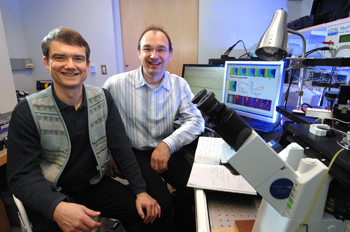
Björn Knollmann, M.D., Ph.D., left, Franz Baudenbacher, Ph.D., and colleagues discovered a new molecular mechanism associated with arrhythmias. (photo by Anne Rayner)
Studies point to novel arrhythmia treatment target
Abnormal heart rhythms — arrhythmias — are killers. They strike without warning, causing sudden cardiac death, which accounts for about 10 percent of all deaths in the United States.
Vanderbilt investigators have discovered a new molecular mechanism associated with arrhythmias. Their findings, reported in The Journal of Clinical Investigation, could lead to novel arrhythmia treatments.
“The current antiarrhythmic drugs do not prolong life,” said Björn Knollmann, M.D., Ph.D., associate professor of Medicine and Pharmacology and the senior author of the current report. “There's a large need for new approaches to antiarrhythmic therapy.”
In their quest to understand how irregular heart rhythms arise — as a way to find new molecular targets for treatment — Knollmann and his colleagues have focused on the role of calcium inside heart muscle cells.
Calcium is central to the contractile cycle. After it is released from its storage sites in heart muscle cells, it interacts with proteins called troponins, part of the cell's myofilament contractile apparatus. The interaction of calcium with troponins regulates myofilament activation and contraction.
Mutations in troponin genes had been linked to inherited forms of hypertrophic cardiomyopathy (HCM), which carries a high risk of sudden cardiac death. HCM is perhaps most famous as a cause of sudden cardiac death in young athletes, but it can affect individuals of any age.
In previous studies, Knollmann's team demonstrated that troponin mutations associated with HCM increase the sensitivity of the troponins to calcium — they bind calcium more readily, which activates the myofilaments more easily and results in stronger contractions.
Increased myofilament calcium sensitivity has also been found in acquired heart diseases, such as heart failure, that have a high incidence of sudden cardiac death, Knollmann said. He and his colleagues proposed that increased myofilament calcium sensitivity contributes to arrhythmia susceptibility.
The researchers examined the heart rhythms of mice expressing various troponin mutants that cause HCM and showed that the mice develop ventricular tachycardia (a particular arrhythmia). The risk for this arrhythmia was directly related to the degree of calcium sensitization caused by the troponin mutation: the higher the calcium sensitivity, the greater the arrhythmia risk.
The investigators then tested whether or not a calcium-sensitizing drug — infused into the mouse heart — would cause arrhythmias. It did.
“We could make a normal heart prone to arrhythmias simply by changing the sensitivity of the myofilaments to calcium,” Knollmann said.
Calcium-sensitizing drugs are used clinically in Europe and Japan to treat heart failure (because they increase the strength of contraction), but they have not been approved for use in the United States. The current studies suggest that these agents would increase the risk of arrhythmias.
In addition to demonstrating that a calcium-sensitizing drug could cause arrhythmias, Knollmann and colleagues showed that an agent that desensitizes the myofilaments — makes them less “willing” to bind calcium — prevented arrhythmias.
The drug they used is limited to in vitro testing, but the studies validate the concept of calcium desensitization as a way to prevent or block arrhythmias.
“The next step is to look for agents that have a desensitizing effect and then try them therapeutically, first in our mouse models, and then potentially further along to patients,” Knollmann said.
“We're excited about these studies because we believe that we have identified a novel mechanism that renders the heart susceptible to arrhythmias and a new therapeutic target for familial hypertrophic cardiomyopathy and other arrhythmia syndromes.”
The first author of the current report, Franz Baudenbacher, Ph.D., assistant professor of Biomedical Engineering and Physics, played a key role in studying the electrical changes that caused the arrhythmias.
Using optical imaging, he and colleagues in the Vanderbilt Institute for Integrative Biosystems Research and Education (VIIBRE) measured how electrical excitation traveled across the hearts expressing troponin mutants or treated with calcium-sensitizing agents. These experiments defined the electrical underpinnings of the arrhythmias.
The National Institutes of Health, the American Heart Association and VIIBRE supported the research.













